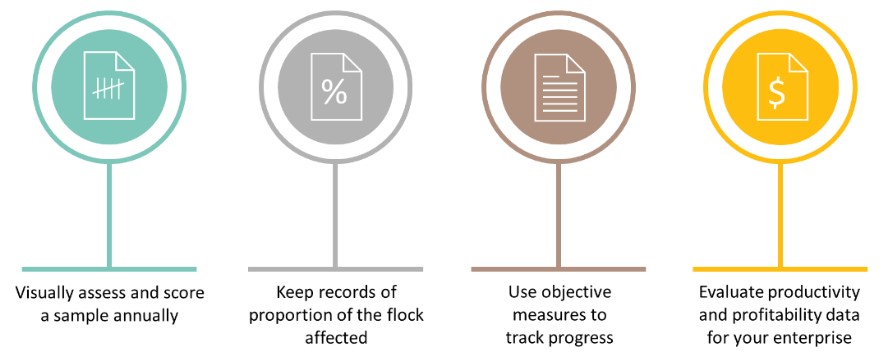Chapter 9.6 Monitoring and reviewing enables continual improvement
Background information
Markets and circumstances change, which can change what fit for farm, fit for market and fit for purpose mean. To ensure your breeding objective remains relevant and in tune with your profit drivers, you should monitor and review the performance of your flock on a regular basis.
At a glance
- Measure and monitor the performance of your sheep visually and genetically against the traits of interest to you.
- Track progress over time and monitor external trends to ensure your breeding objective remains relevant.
- Monitor business performance to ensure your breeding objective is having a positive impact on profitability.
Track your progress against your breeding objective
You can track progress towards your breeding objective by monitoring and reviewing progress at regular intervals.
Ways to do this include:
- Visually assessing and scoring a sample of ewes and lambs annually.
- For traits that predispose sheep to conditions, such as flystrike or internal parasites, keeping records of the proportion of the flock that are affected, and the extent to which they are affected.
- Using objective measures to track progress such as:
- Recording the average ASBVs for your ram team every joining. Include new rams purchased and exclude rams no longer being used. RamSelect’s My Ram Team Manager can help you with this.
- Undertaking a Flock Profile (via DNA testing) every four years if ASBVs are unavailable.
- Recording the average ASBVs for your ram team every joining. Include new rams purchased and exclude rams no longer being used. RamSelect’s My Ram Team Manager can help you with this.
- Evaluating productivity and profitability data for your enterprise, including market feedback.

Source: AWI ClassiFly
When reviewing your information, consider and try to quantify improvement in your ram team and your flock. You may need to make adjustments to your breeding program based on your monitoring but it's important to allow enough time for your investment in genetics to take effect. Resist the temptation to make erratic changes and chase fads.
It takes a significant amount of time for today’s genetic decision to be seen or measured in your flock.
When you are making breeding decisions, you typically need to allow 5-10 years to achieve your targets. Some may be achieved sooner than others.
A five-year horizon is often used as this is typically how long it takes for the first lambs born based on your genetic decisions to move through the flock and be culled based on age.
Now is the best time to start for most of your breeding targets; however, consider how you can prioritise what you want to achieve and ensure you have an appropriate level of focus on these. You can chase the high priority targets first and then refocus on the medium and lower priority ones once you have made progress.
Review your breeding objective regularly
You can’t set and forget a breeding objective based on the assumption that all things will remain equal. Markets and circumstances change and it’s important that you stay abreast of what’s driving profit in your business and respond accordingly.
Consider whether your breeding objective is still relevant or has the market fundamentally changed? Are there new internal and external factors that will impact your operation that you need to consider and plan for?
Maintain a watching brief on future developments: breeding technology, production landscape, consumer priorities and expectations, social licence, regulation and research updates should all be considered.
Has your progress been quicker than expected and do your priorities need to change? Is your ram source keeping pace and continuing to lead you where you want to go? Does your ram source’s breeding objective remain consistent with your breeding objective?
While breeding is a long-term activity and it’s not advisable to change direction regularly, it is important to adjust your targets as you make progress and circumstances change.
SIGNPOSTS
READ
AWI’s genetics R&D is focused on better understanding and Improving lifetime productivity from Merino sheep and improved sustainability and productivity whilst meeting consumer expectations.
MLA’s investment in livestock genetics R&D aims to improve the rate of genetic progress in the beef cattle and sheep industries to permanently improve on-farm productivity and animal health and contribute towards meeting consumer demands.
Sheep Genetics is the genetic evaluation service of the Australian sheep industry.
Sheep Genetics help you breed or buy animals using Australian Sheep Breeding Values (ASBVs) through LAMBPLAN and MERINOSELECT and produce tools and information to help you breed better animals.
A clear look at how better breeding values can help you accelerate your flock’s productivity.
USE
A broad review of the global market for wool and competitor fibres, including wool production forecasting, retail and trade market reports, consumer insights and trend monitoring, and fibre market research.
Latest pricing, reporting, forecasts and analysis for Australian and international red-meat markets.
A tool for helping you select the best rams for your flock.
ATTEND
A one-day workshop to increase skills and awareness in breeding for flystrike resistance.
A practical, one-day workshop highlighting the key production benefits of superior genetics, plus feed management for improved reproductive performance and livestock productivity.






